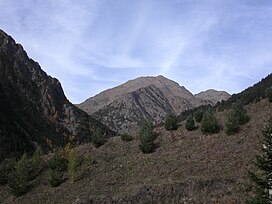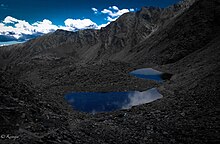Coma Pedrosa
| Coma Pedrosa | |
|---|---|
 Coma Pedrosa in October 2006 | |
| Highest point | |
| Elevation | 2,943 m (9,656 ft)[1] |
| Prominence | 434 m (1,424 ft)[1] |
| Listing | Country high point |
| Coordinates | 42°35′26″N1°26′41.21″E/ 42.59056°N 1.4447806°E |
| Geography | |
| Location | Parish ofLa Massana,Andorra |
| Parent range | Pyrenees |
 | |
Coma Pedrosa(Catalan pronunciation:[ˈkoməpəˈðɾozə];2,943 m or 9,656 ft) is the highest mountain in the principality ofAndorra.[2]It is popular with mountain climbers, its ascent being technically straightforward, although strenuous. From Arinsal to Camp de Refuge (650 m climb) is considered moderate meanwhile the last 862 m is considered to be difficult. Several mountain lakes andtarnsare found on the slopes, notablyEstanys de Baiau,which lies on the western slopes, across theSpanishborder.
The nearest town isArinsal,La Massana.Historically, the mountain provided ample security from invasions into Andorra.[3]Nowadays, the mountain is part of theParc Natural Comunal de les Valls del Comapedrosanational park.
Geography
[edit]
Coma Pedrosa, shaped like a pyramid,[4]is situated at the northwestern border withFranceand Spain. It has in the past acted as a barrier between Andorra and France. The mountainous terrain of Andorra, a landlocked country, contains 65 peaks that rise to an elevation of greater than 2,000 m (6,562 ft), and of the 65 peaks, Coma Pedrosa has the highest one at 2,943 m (9,656 ft).[5]
Its recent exposure to tourism has attracted millions to enjoy the unique scenery of its hills and valleys.[5]The higher reaches of the mountain are covered with forests while the lower reaches have some arable lands. The mountain gets fully covered with snow during the winter months which provides opportunities for skiing and mountaineering, ice climbing and scrambling. During the summer season, the mountain provides many easy routes for trekking through the Arinsal valley covering neighbouring areas ofVall FerrerainSpainafter crossing the mountain passBaiau.[6][7]
The town of Arinsal is in the narrow valley below the mountain. The Coma Pedrosa'sEstany Negre,the Torta Coma, Coma's Gaspedrosa, the Puestode las Erolas, Cape dels Croes, and Puig dels Emborts in the Sierra del Aguiro surround the parish of La Massana.[8]
The local area is known as Comapedrosa. The mountain is in a natural park calledParque Natural Comunal de los Valles del Comapedrosa(Communal natural park of the Comapedrosa valleys).[citation needed]
Vegetation
[edit]The forest vegetation on the mountain and in its valleys are of pines, birch and firs. There are several glacier lakes formed within the valley created by the mountains and also vast meadows. Consequent to the popularity of skiing in and around this mountain valley near Arinsal and close to the Andorra la Vella and other valleys in Andorra, the valley has seen an increase in the development of tourist resorts, hotels, restaurants and business establishments catering to tourists.[citation needed]This has created an awareness to preserve virgin mountains and forests, and put restrictions on further proliferation of ski resorts and urban activities by introducing a national network of parks as preserves.[7]
Climate
[edit]Coma Pedrosa is classified as asubalpineclimate (ET), due to fewer than 4 months with an average temperature above 10°C (50°F).
| Climate data for Coma Pedrosa (1971–2000) | |||||||||||||
|---|---|---|---|---|---|---|---|---|---|---|---|---|---|
| Month | Jan | Feb | Mar | Apr | May | Jun | Jul | Aug | Sep | Oct | Nov | Dec | Year |
| Mean daily maximum °C (°F) | 1.2 (34.2) |
1.8 (35.2) |
3.5 (38.3) |
4.3 (39.7) |
8.6 (47.5) |
13.0 (55.4) |
18.1 (64.6) |
18.1 (64.6) |
14.4 (57.9) |
9.0 (48.2) |
5.3 (41.5) |
2.8 (37.0) |
5.4 (41.7) |
| Daily mean °C (°F) | −2.0 (28.4) |
−1.7 (28.9) |
−0.2 (31.6) |
0.4 (32.7) |
4.0 (39.2) |
7.6 (45.7) |
11.6 (52.9) |
12.0 (53.6) |
9.1 (48.4) |
4.9 (40.8) |
1.2 (34.2) |
−0.4 (31.3) |
1.7 (35.1) |
| Mean daily minimum °C (°F) | −4.7 (23.5) |
−5.0 (23.0) |
−4.0 (24.8) |
−3.5 (25.7) |
−0.6 (30.9) |
2.3 (36.1) |
5.2 (41.4) |
5.2 (41.4) |
2.9 (37.2) |
0.1 (32.2) |
−2.5 (27.5) |
−4.0 (24.8) |
−1.7 (28.9) |
| Averageprecipitationmm (inches) | 86.3 (3.40) |
65.3 (2.57) |
70.2 (2.76) |
117.5 (4.63) |
134.8 (5.31) |
133.2 (5.24) |
88.6 (3.49) |
112.3 (4.42) |
112.1 (4.41) |
114.8 (4.52) |
113.9 (4.48) |
106.5 (4.19) |
1,255.5 (49.42) |
| Source: ACDA[9] | |||||||||||||
Tourism
[edit]

The trek or the mountain climb starts from Arinsal, which is considered an easy route, from the picnic area at the base of the Ribal Warefall at 1,580 metres (5,180 ft). It takes about 4 to 41⁄2hours to reach the highest point of Pic de Coma Pedrosa. The first part of the climb, taking just under half an hour, is along a wide, 800 metres (2,600 ft) long foot track past a signpost toAigues Juntes,which is the confluence of the Coma Pedrosa River and Pla de l'Estany River rising from the mountains and arriving at Grau. The ascent continues along a steep hill slope of the Coma Pedrosa River valley and arrives at the Coma Pedrosa refuge or camping site at an elevation 2,272 metres (7,454 ft), which is located near the l'Estany de les Truites (Trout Lake). A further hour's walk leads to the Estany Negre (Black Lake), named on account of its colour. The last stretch is for about one hour from Estany Negre to the highest peak in Andorra at 2,943 metres (9,656 ft) elevation, and this trek, passing through rocky terrain, is difficult. The return trek follows the same route. A diversion through Malhiverns pass instead of Estany Negre is more enjoyable.[10][11][12]
In theArinsalvalley below the Coma Pedrosa, winter season offers skiing and snowboarding. The first ski lifts were installed in Arinsal in 1973. It is 10 kilometres (6.2 mi) northwest of Andorra la Vella and 5 kilometres (3.1 mi) northwest of Massana, providing a pleasant après-ski sight.[13][14]At an elevation of 2,260 metres (7,410 ft) liesRefugi de Coma Pedrosa,a mountain hut.[15]It was inaugurated in 1992.[16]
References
[edit]- ^abPic de Coma Pedrosa, AndorraPeakbagger. Retrieved 11 December 2022
- ^Simonis, Damien (October 2003).Catalunya & the Costa Brava.Lonely Planet. p. 247.ISBN978-1-74059-381-6.
- ^Augustin, Byron (January 2009).Andorra.Marshall Cavendish. pp.8–.ISBN978-0-7614-3122-0.Retrieved22 December2010.
- ^Balari Y Jovany, Jose (2009).Orígens històrics de Catalunya(in Catalan). Editorial MAXTOR. p. 60.ISBN978-84-9761-677-5.Retrieved22 December2010.
- ^abAugustin, Byron (2009).Andorra.p. 8.ISBN9780761431220.Retrieved22 December2010.
- ^Eur (2002).Western Europe 2003.Europa. p. 41.ISBN978-1-85743-152-0.
- ^ab"Coma Pedrosa".Summitpost.org.Retrieved22 December2010.
- ^Bladé, Jean-François (1875).Études géographiques sur la vallée d'Andorre(in French). J. Baer et cie. p. 37.
- ^"Comapedrosa averages (1971–2000)"(in Spanish). Atles Climàtic Digital d'Andorra. Archived fromthe originalon 30 August 2017.Retrieved19 June2016.
- ^Alf Robertson; Jane Meadowcroft (November 2005).The Mountains of Andorra: Walks, Scrambles, Via Ferratas, Treks.Cicerone Press Limited. p. 46.ISBN978-1-85284-424-0.
- ^Kev Reynolds(October 2007).Walks and Climbs in the Pyrenees.Cicerone Press Limited. pp. 398–400.ISBN978-1-85284-470-7.
- ^"The" Coma Pedrosa "2942 m:Tackle the highest mountain in Andorra".Hola-andorra. Archived fromthe originalon 4 December 2012.Retrieved22 December2010.
- ^Damien Simonis (15 March 2007).Spain.Lonely Planet. pp.404–.ISBN978-1-74104-554-3.Retrieved22 December2010.
- ^Loretta Chilcoat; Reuben Acciano (2005).Western Europe.Lonely Planet. p. 30.ISBN978-1-74059-927-6.
- ^Dubin, Marc (2004).The rough guide to the Pyrenees.Rough Guides. p. 218.ISBN978-1-84353-196-8.
- ^"Refugios".Andorra. Archived fromthe originalon 12 December 2010.Retrieved22 December2010.

